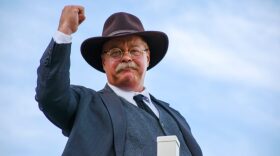In March 1912, North Dakota was the first to vote in the Republican Party’s presidential primaries. Theodore Roosevelt, who was president just four years before, was one of those challenging incumbent president, William Taft.
Theodore Roosevelt remained popular in North Dakota, but aside from Taft, there was a third challenger on the ballot -- Robert La Follette of Wisconsin. On this date, La Follette announced that he would visit North Dakota on his campaign for the nomination.
The Bismarck Daily Tribune noted that there was a “Roosevelt tide” in the state. Roosevelt had not yet visited the state during the current campaign, but rallies for Roosevelt were popular. In contrast, only 65 people showed up on this date for a La Follette rally in Mandan.
North Dakota newspapers recognized that a visit by La Follette would counter and possibly overcome the large support for Roosevelt. Many North Dakotans speculated that Roosevelt would respond by making his own visit. That didn't come until September 6, after he had left the Republican party to run under the banner of the Progressive, or "Bull Moose" party.
North Dakota Senator Asle J. Gronna was a supporter of La Follette, and he went ahead of La Follette to stir up support. He was confident that La Follette would ultimately defeat Roosevelt in the North Dakota primary. La Follette came to North Dakota on March 14, making stops in various towns, including Fargo, Valley City, Jamestown, Bismarck, Mandan, and Grand Forks. He finished his tour on the 16th, just three days before the primary.
Apparently, Senator Gronna was right. La Follette defeated Roosevelt by a margin of around 10,000 votes – a “veritable landslide,” as the Bismarck Daily Tribune proclaimed. Taft got very few votes by comparison.
North Dakota’s results turned out to be almost opposite from the results at the Republican National Convention, for on June 23, Taft was re-nominated with 561 delegates. La Follette had only 41 delegates, and that's when Roosevelt, with 350 delegates, left the Republicans to form the Progressive Party.
None of the men mentioned so far were elected president that year. With the Republican vote divided, Woodrow Wilson would have an easy victory, even winning in North Dakota.
Dakota Datebook by Jacob Dalland
Sources:
Bismarck Daily Tribune. March 9, 1912. Pages 1-2
Bismarck Daily Tribune. March 20, 1912. Page 3
The Evening Times. June 24, 1912. Page 6
The Fargo Forum and Daily Republican. March 9, 1912. Page 1
The Hope Pioneer. November 7, 1912. Page 2
The Ward County Independent. September 12, 1912. Page 16




